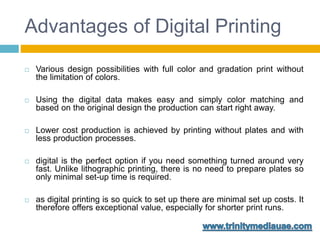The 7-Minute Rule for Digital Printing
The 7-Minute Rule for Digital Printing
Blog Article
A Biased View of Digital Printing
Table of ContentsDigital Printing - TruthsWhat Does Digital Printing Do?The 7-Second Trick For Digital PrintingGet This Report about Digital PrintingThe Greatest Guide To Digital PrintingHow Digital Printing can Save You Time, Stress, and Money.
Variable information printing, such as straight mail with customized codes and addresses, is ideally fit for electronic printing. Digital quick printing just requires four steps of style, testimonial, printing and binding to get every little thing done. Digital quick printing has an unparalleled benefit: print on demand.According to PMMI, digital printing permits brand names and producers to react promptly to client needs while enhancing the supply chain, lowering warehousing price and waste, and appreciating faster time to market. That all sounds great, but exactly how does this technology do all that? The major differentiator of these innovations is that there are no set up costs and no plates with electronic printing.
Digital Printing Can Be Fun For Everyone
This results in quicker turn-around time and lowers cost when utilizing electronic printing.
Speedy manufacturing suggests getting your product to market much faster. It likewise means it's easier and faster to make adjustments later, when you alter a dish, add a SKU, or develop seasonal product packaging. Digital printing is highly adaptable, so it's easy to make adjustments to the bundle style swiftly. All of it returns to home plates.
Much more supply can suggest even more waste down the road. With conventional printing techniques, short-run printing is just not feasible. Since a fantastic style can make or damage your product, electronic printing consistently develops premium, clear and vibrant graphics each time. Digital printing on versatile bags includes the brilliant, lively, and exact graphics that virtually beckon consumers to connect and touch them.
Digital printing is the procedure of printing digital-based photos directly onto a variety of media substratums. There is no demand for a printing plate, unlike with balanced out printing. Digital documents such as PDFs or desktop computer posting files can be sent out straight to the electronic printing press to publish theoretically, photo paper, canvas, fabric, synthetics, cardstock and various other substrates.
The Basic Principles Of Digital Printing
According to PMMI, electronic printing enables brand names and makers to respond promptly to consumer demands while enhancing the supply chain, reducing warehousing price and waste, and taking pleasure in faster time to market. That all sounds great, but just how does this innovation do all that? The major differentiator of these technologies is that there are no set up fees and no plates with digital printing.
This results in quicker turnaround time and decreases price when using electronic printing.

The 4-Minute Rule for Digital Printing
A lot more supply can indicate more waste down the road. With conventional printing approaches, short-run printing is simply not feasible. Due to the fact that a wonderful design can make or damage your item, electronic printing regularly produces high-grade, clear and vibrant graphics each time. Digital printing on flexible pouches includes the brilliant, lively, and precise graphics that Read Full Article practically beckon consumers to get to out and touch them.

According to PMMI, electronic printing allows brands and suppliers to react rapidly to consumer demands while improving the supply chain, minimizing warehousing cost and waste, and delighting in faster time to market. That all noises fantastic, however how does this modern technology do all that? The significant differentiator of these modern technologies is that there are no set up costs and no plates with electronic printing.
Unknown Facts About Digital Printing
According to Wikipedia, the best difference between electronic printing this content and traditional approaches such as lithography, flexography, gravure, or letterpress is that there is no requirement to change printing plates in electronic printing, whereas in these analog printing techniques the plates are continuously replaced. This causes quicker turn-around time and decreases cost when utilizing electronic printing.
Fast manufacturing indicates getting your item to market quicker. It also means it's less complicated and faster to make changes in the future, when you transform a recipe, add a SKU, or develop seasonal packaging. Digital printing is very adaptable, so it's simple to make adjustments to the plan style promptly. It all goes back to home plates.

Digital Printing Fundamentals Explained
Digital printing is the process of printing digital-based Read Full Report images straight onto a selection of media substratums. There is no requirement for a printing plate, unlike with balanced out printing. Digital data such as PDFs or desktop computer publishing data can be sent out straight to the electronic printing machine to publish theoretically, image paper, canvas, material, synthetics, cardstock and other substratums.
Report this page